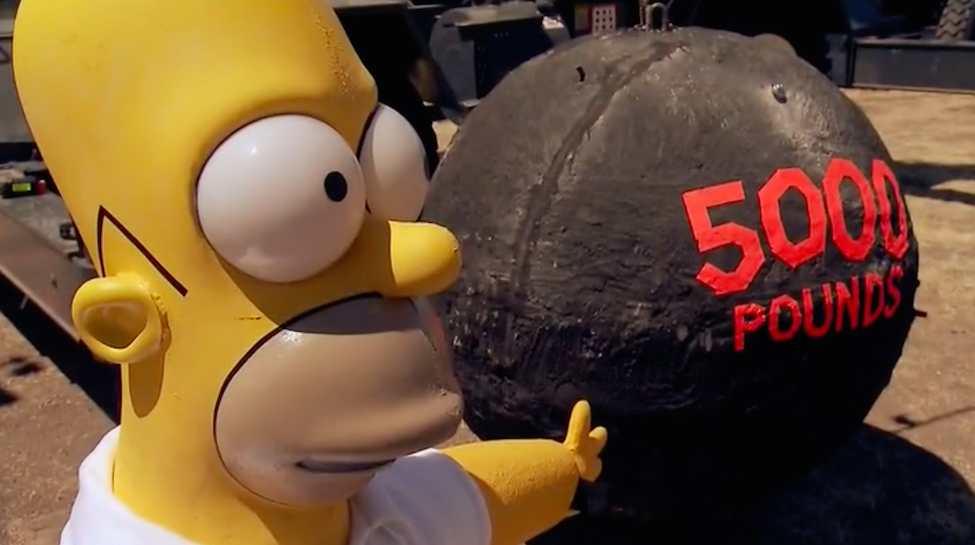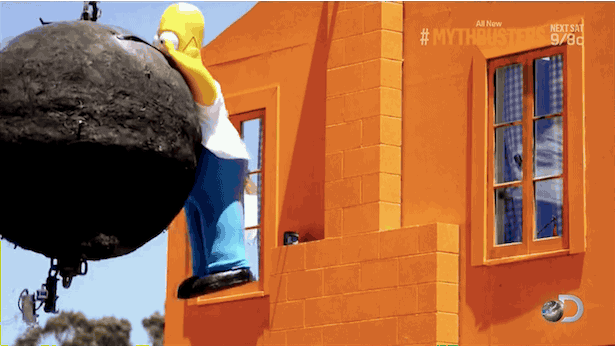 One of the most iconic moments from 2007’s The Simpsons Movie had the titular family’s home in danger of being destroyed with a wrecking ball until Homer selflessly jumps on it to cushion the blow. Thanks to the physics of cartoons, it worked and Homer saved the house and was his family’s hero. The joke was, of course, that Homer has such a fat belly that it was able to stop a 5,000 wrecking ball from smashing through his home. It was funny, at least to me, because it was so absurdly implausible.
One of the most iconic moments from 2007’s The Simpsons Movie had the titular family’s home in danger of being destroyed with a wrecking ball until Homer selflessly jumps on it to cushion the blow. Thanks to the physics of cartoons, it worked and Homer saved the house and was his family’s hero. The joke was, of course, that Homer has such a fat belly that it was able to stop a 5,000 wrecking ball from smashing through his home. It was funny, at least to me, because it was so absurdly implausible.
When a television show gets a little long in the tooth, producers have a tendency to get a little desperate for content. So when a show like MythBusters, which revolves around proving or disproving urban legends and myths, reaches fourteen seasons the list of myths that make for good TV starts to get a little short. And that’s how we get here, watching a, episode where the entertainingly nerdy hosts Adam Savage and Jamie Hyneman try to prove or disprove the physics of a cartoon.
In typical MythBusters fashion, Adam and Jamie break down the myth, apply some math to it, and figure out the best way to replicate its conditions in order to observe the results. In this case it meant creating a life-sized replica of Homer and literally putting him in the path of a 5,000 pound ball. Luckily Adam and Jamie are two of the entertainment industry’s best special effects maestros. After building Homer’s body to scale, they turned to special effects whiz Merrick Cheney from Mechinations to help reproduce Homer’s instantly recognizable head.
Take a look at the MythBusters’ Simpsons episode trailer:
 Adam and Jamie wanted to make a flexible, rubber head rather than a 3D printed one, so Cheney created a digital file of Homer’s head, scaled it to size and ran it through Magics software from Materialise.
Adam and Jamie wanted to make a flexible, rubber head rather than a 3D printed one, so Cheney created a digital file of Homer’s head, scaled it to size and ran it through Magics software from Materialise.
Magics is an STL editing and optimization program that allows users to instantly orientate 3D models in the optimal printing position, or organically divide a larger object into smaller parts that would then be assembled. The STL can then be sent to a waiting 3D printer or, in the case of Homer’s noggin, a CNC machine that will tool a mold that Adam and Jamie can fill with a flexible rubber material.
“The great thing about Magics is that it can fix big STL files. All tools in Magics were useful for making the mold. You can clean up your file to get watertight data that can be used for 3D Printing or send your fixed files to a CNC milling machine,” Cheney explained to Materialise.
In order to produce Homer’s head at a large enough size to fit his body Cheney needed to divide the mold’s STL file into eight individual parts. Once he had milled all eight of them, he assembled the full mold and passed it back to Adam and Jamie to complete Homer’s hilariously massive head. The piece created from the mold was coated with a Simpsons-yellow latex coating and filled with the quick drying rubber, then had the final details painted on.
 As you can see, the fat Homer body did in fact save the replica house from being smashed by the 5,000 pound wrecking ball. Although the fake house took some damage, it didn’t take as much as the control house that they tested without Homer, so Adam and Jamie declared it “Plausible.” You can see the final impact in slow motion below. And if you saw the Simpsons episode of MythBusters you can tell us what you thought of their science in our MythBusters Builds a Life Size Homer forum at 3DPB.com.
As you can see, the fat Homer body did in fact save the replica house from being smashed by the 5,000 pound wrecking ball. Although the fake house took some damage, it didn’t take as much as the control house that they tested without Homer, so Adam and Jamie declared it “Plausible.” You can see the final impact in slow motion below. And if you saw the Simpsons episode of MythBusters you can tell us what you thought of their science in our MythBusters Builds a Life Size Homer forum at 3DPB.com.
Subscribe to Our Email Newsletter
Stay up-to-date on all the latest news from the 3D printing industry and receive information and offers from third party vendors.
You May Also Like
Gorilla Sports GE’s First 3D Printed Titanium Cast
How do you help a gorilla with a broken arm? Sounds like the start of a bad joke a zookeeper might tell, but it’s an actual dilemma recently faced by...
Nylon 3D Printed Parts Made More Functional with Coatings & Colors
Parts 3D printed from polyamide (PA, Nylon) 12 using powder bed fusion (PBF) are a mainstay in the additive manufacturing (AM) industry. While post-finishing processes have improved the porosity of...
$25M to Back Sintavia’s Largest Expansion of Metal 3D Printing Capacity Since 2019
Sintavia, the digital manufacturing company specializing in mission-critical parts for strategic sectors, announced a $25 million investment to increase its production capacity, the largest expansion to its operations since 2019....
Velo3D Initiates Public Offering in a Bid to Strengthen Financial Foundations and Drive Future Growth
Velo3D (NYSE: VLD) has been among a number of publicly traded 3D printing firms that have attempted to weather the current macroeconomic climate. After posting a challenging financial report for 2023,...































